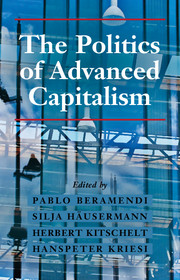Book contents
- Frontmatter
- Contents
- List of Figures
- List of Tables
- List of Contributors
- Preface
- 1 Introduction: The Politics of Advanced Capitalism
- PART I STRUCTURAL TRANSFORMATIONS
- Part II Politics
- Part III Policies
- Part IV Outcomes
- 13 Constrained Partisanship and Economic Outcomes
- 14 Happiness and the Welfare State: Decommodification and the Political Economy of Subjective Well-Being
- 15 Conclusion: Advanced Capitalism in Crisis
- Reference
- Index
14 - Happiness and the Welfare State: Decommodification and the Political Economy of Subjective Well-Being
from Part IV - Outcomes
Published online by Cambridge University Press: 05 May 2015
- Frontmatter
- Contents
- List of Figures
- List of Tables
- List of Contributors
- Preface
- 1 Introduction: The Politics of Advanced Capitalism
- PART I STRUCTURAL TRANSFORMATIONS
- Part II Politics
- Part III Policies
- Part IV Outcomes
- 13 Constrained Partisanship and Economic Outcomes
- 14 Happiness and the Welfare State: Decommodification and the Political Economy of Subjective Well-Being
- 15 Conclusion: Advanced Capitalism in Crisis
- Reference
- Index
Summary
Do welfare states make people happy? In this chapter, we argue that the answer depends critically on how we conceptualize welfare states and the logics that underpin their presumed connection with well-being. In particular, we contend that understanding the relationship between welfare states and happiness requires that we distinguish between the “how much” protection welfare states offer and “what kind” of labor market opportunities they provide to go along with that protection. Welfare states are about more versus less protection, but they also are about whom they protect and in what way. This matters for happiness; more protection produces more happiness for those at risk, but having more flexible labor markets produces more happiness, too, even if a country's overall levels of protection are lower.
To make our argument and organize the empirical analysis, we rely critically on two concepts. The first is that of decommodification, taken from Gøsta Esping-Andersen's (1985) work. Decommodification means that people's access to basic resources needed to sustain their lives is protected from market risks to which they would be exposed if illness, old age, and unemployment would disrupt market-based resource flows. Decommodification supplies life satisfaction by granting peace of mind. The second concept is that of human capacities to choose one's own life and competently cope with challenges, which we take from Armatya Sen's (2011) The Idea of Justice. People's happiness depends on their capabilities and ability to make choices. This requires freedoms but also investments in their capabilities, skills, and competences.
The experience of freedom and choice, particularly in labor markets, provides fulfillment that translates into life satisfaction. In this vein, a highly regulatory welfare state, conferring little freedom of choice on people, for example, in labor markets, may generate less life satisfaction than a freedom-inducing welfare state, even if decommodification is equally high. So instead of more decommodifying welfare states simply making all or most citizens a bit happier than less decommodifying ones, different kinds of welfare states also create distinct sets of more or less happy citizens across countries.
- Type
- Chapter
- Information
- The Politics of Advanced Capitalism , pp. 357 - 380Publisher: Cambridge University PressPrint publication year: 2015
- 6
- Cited by

